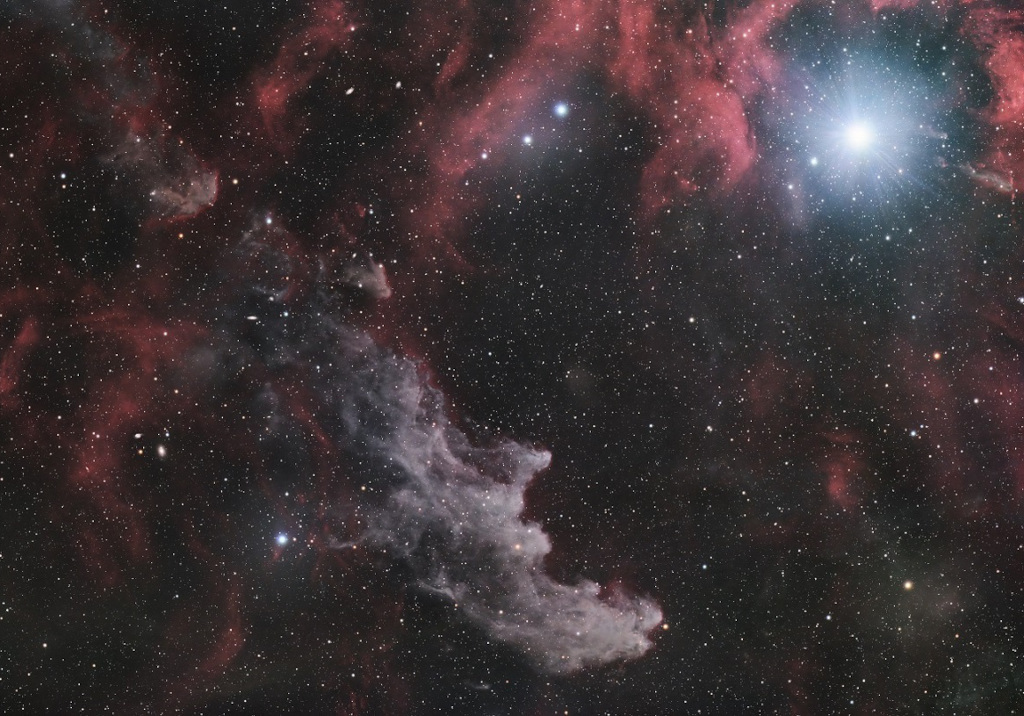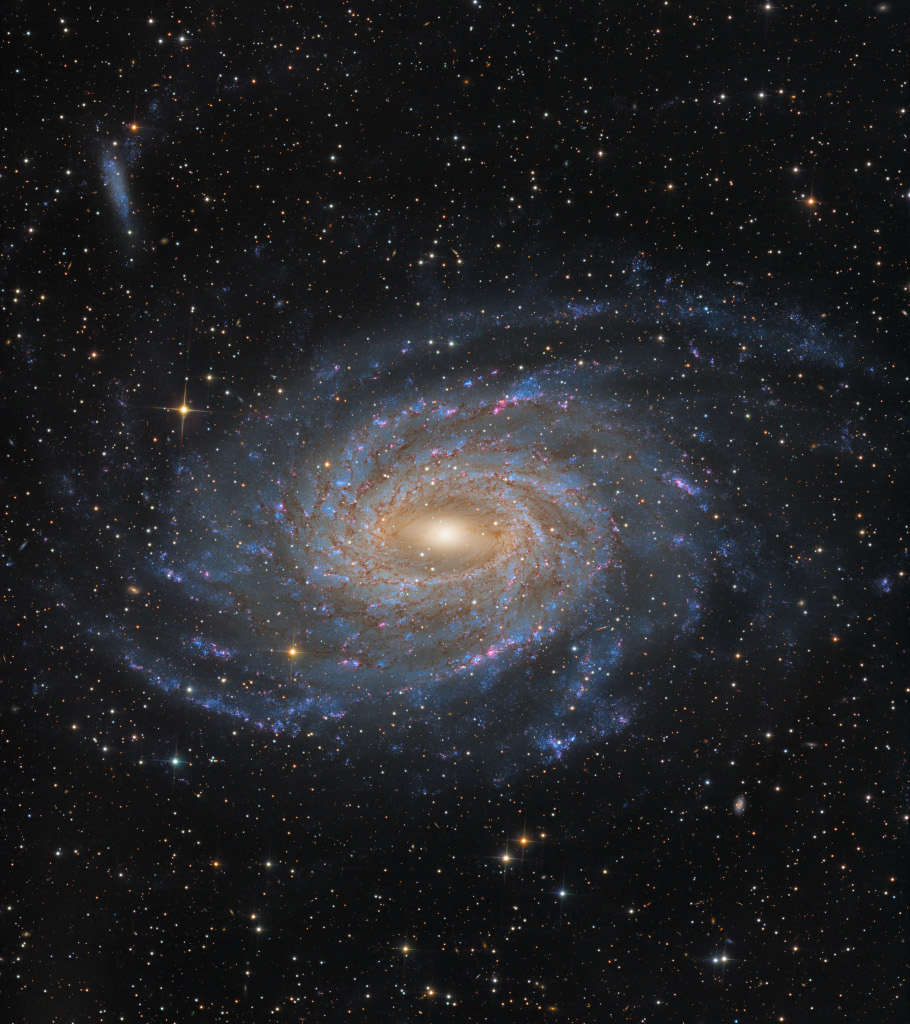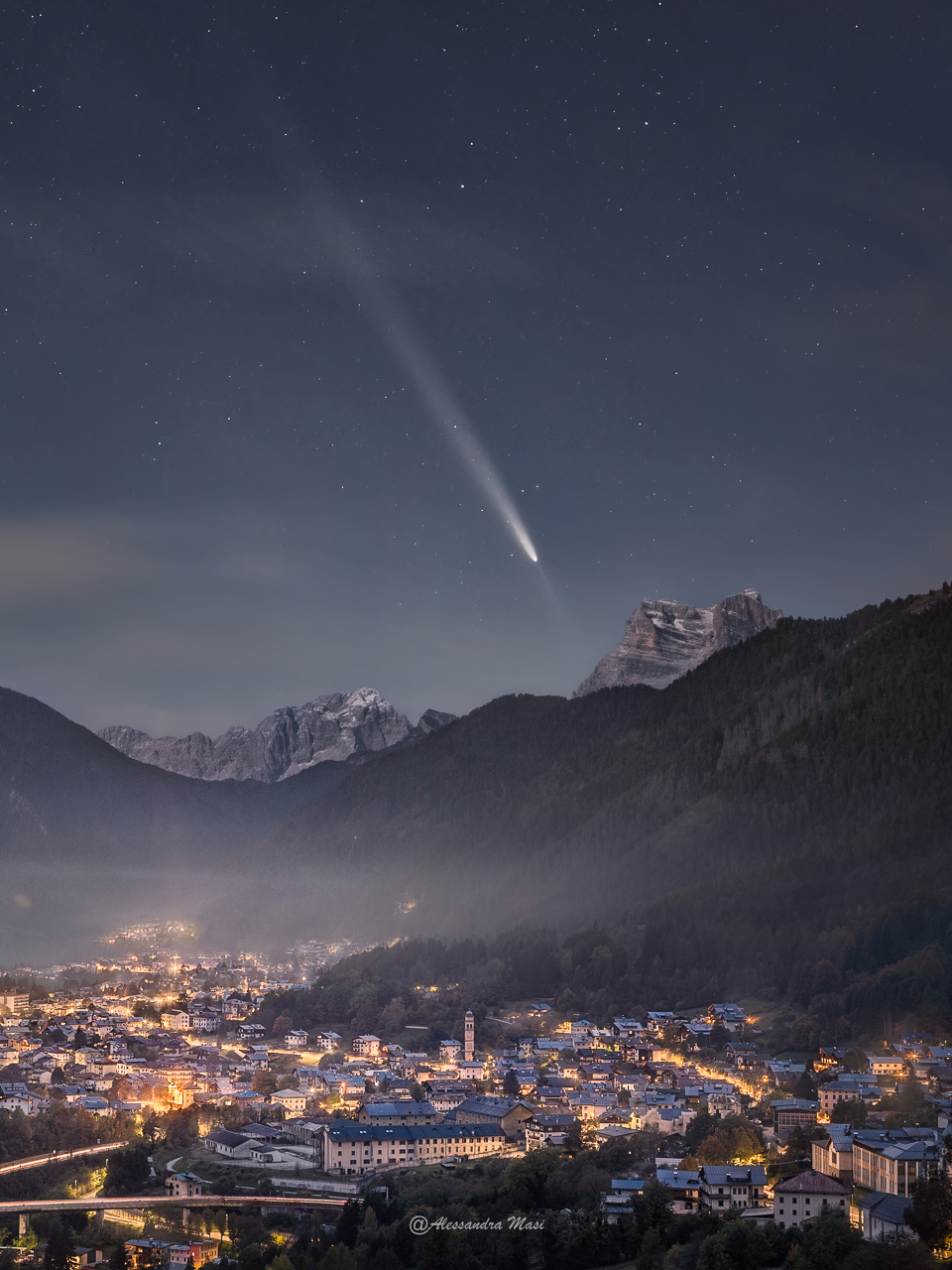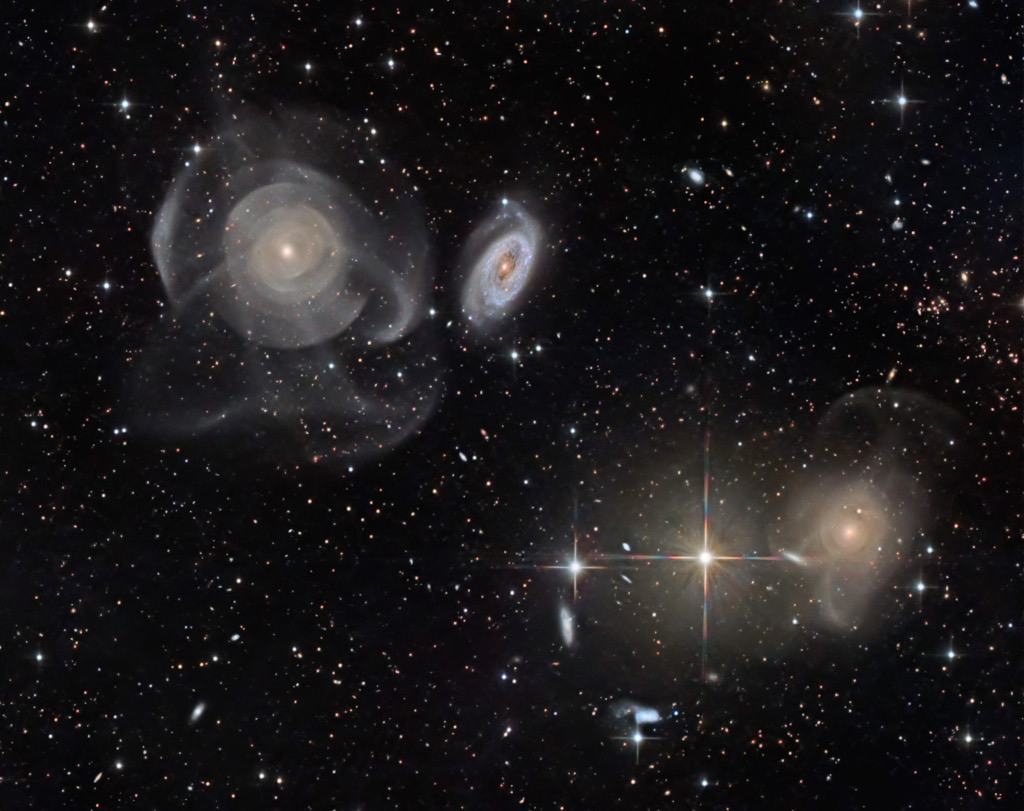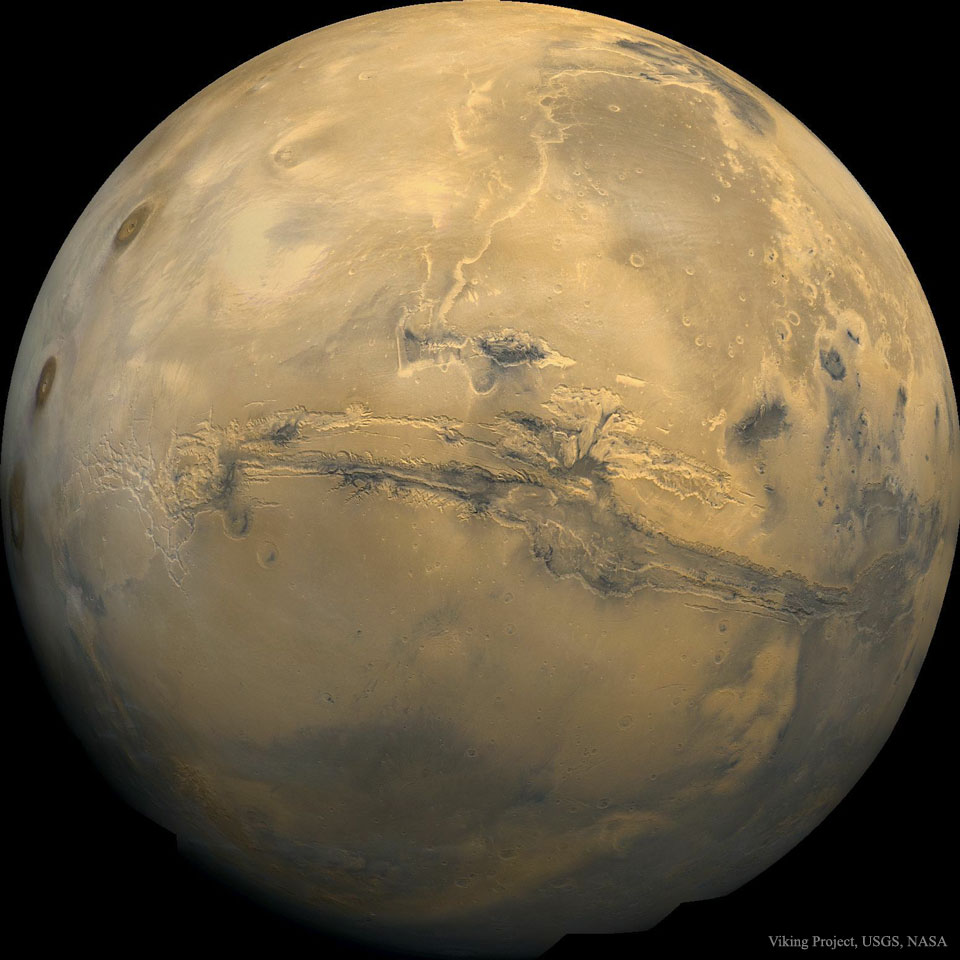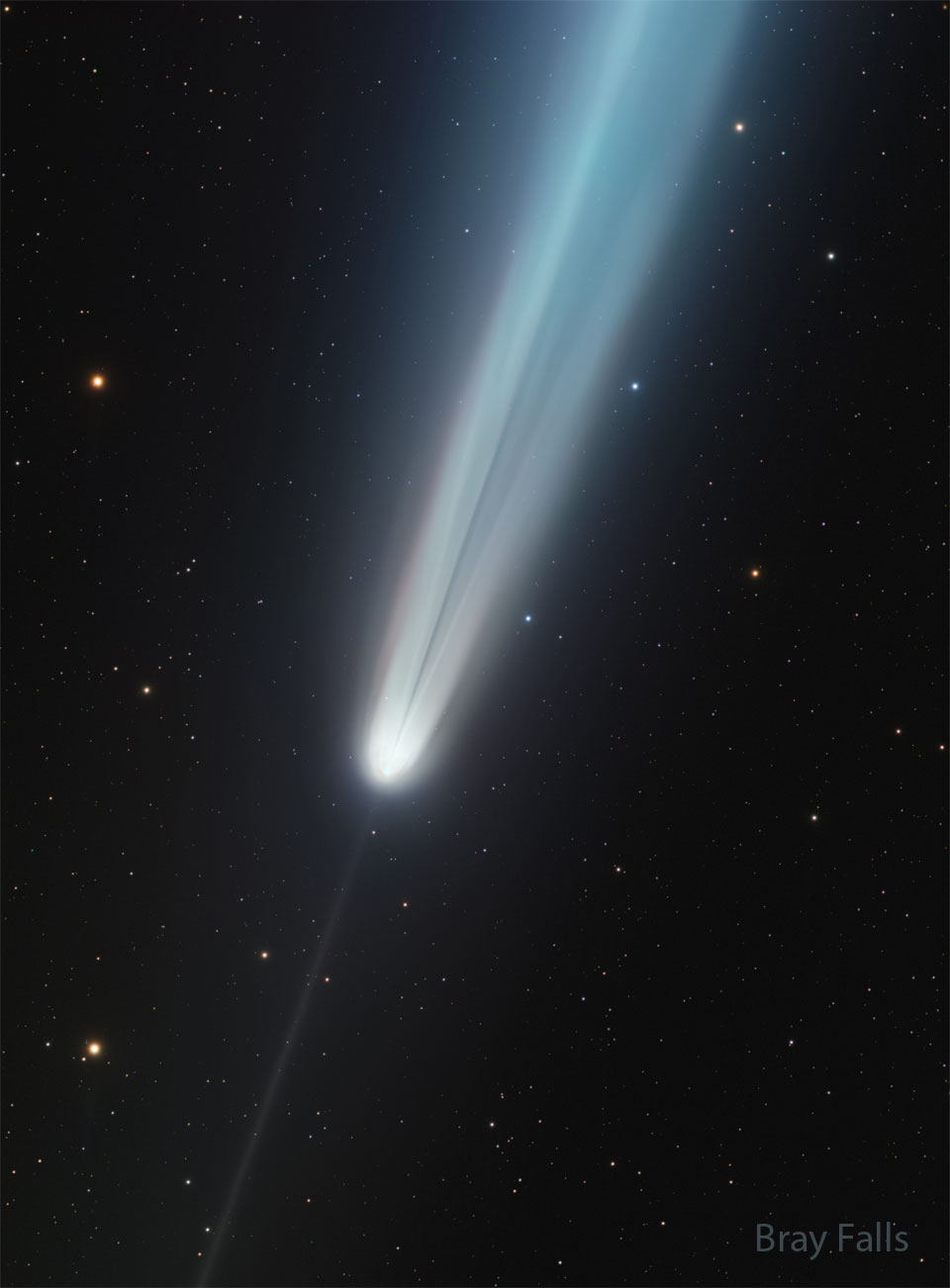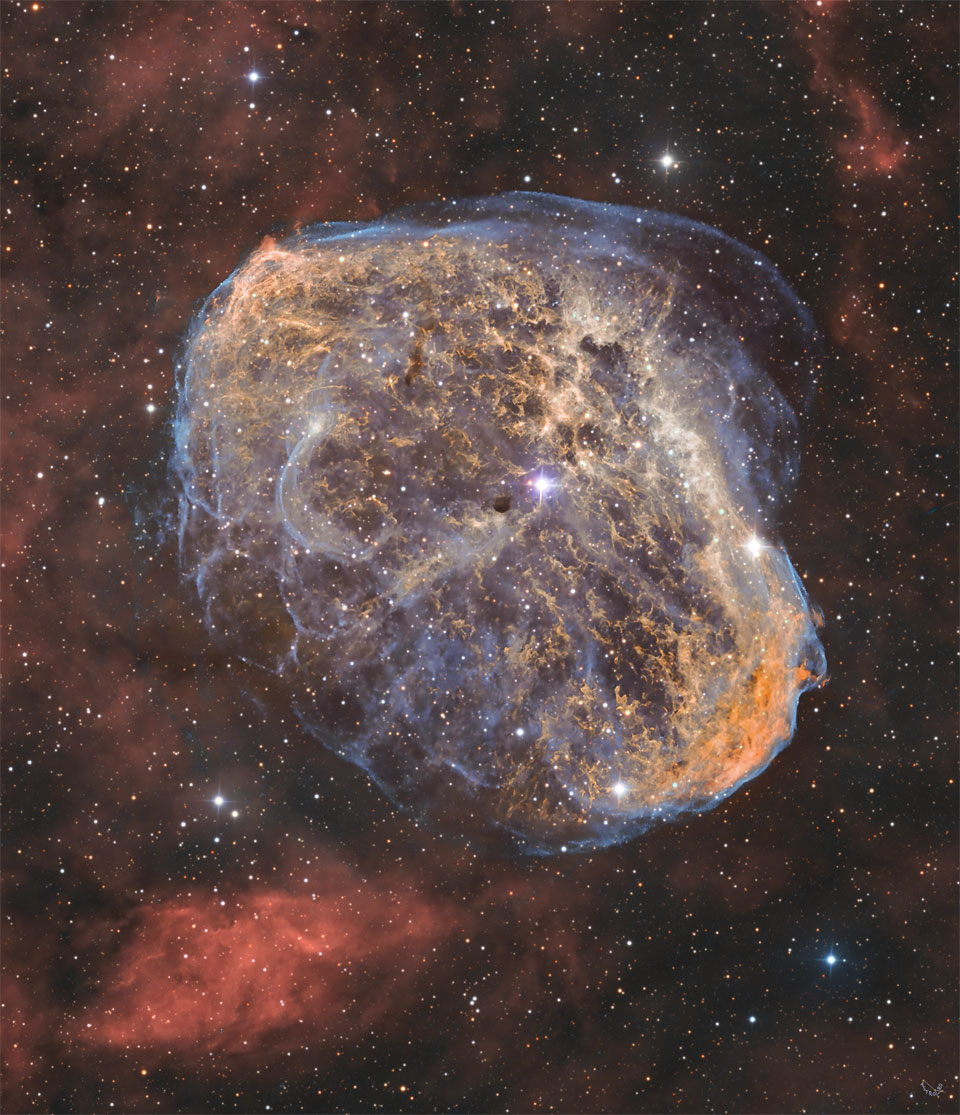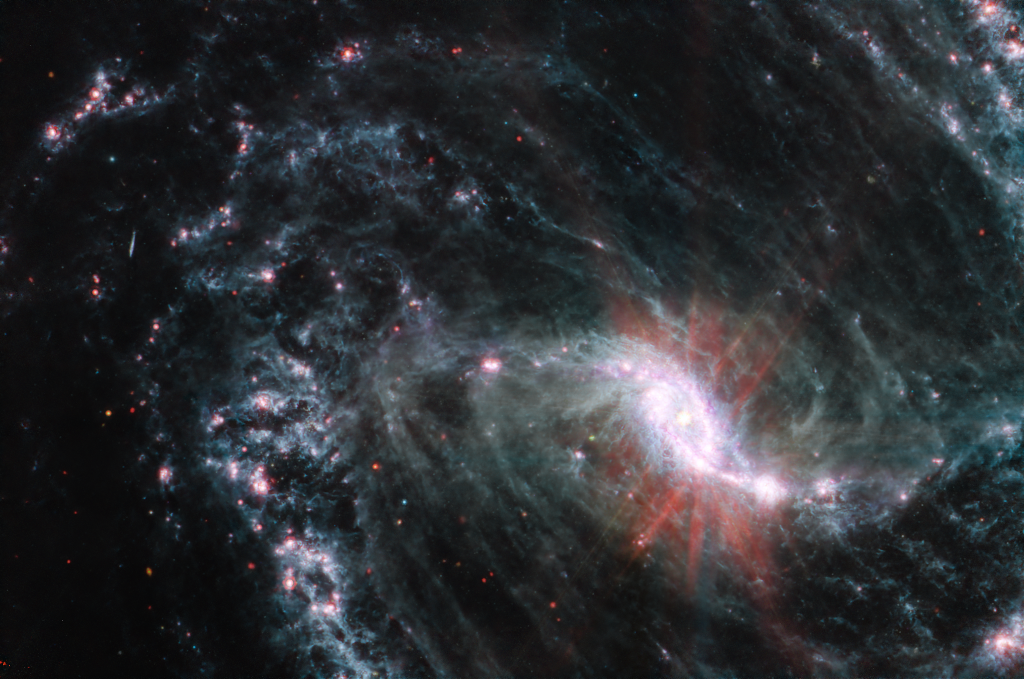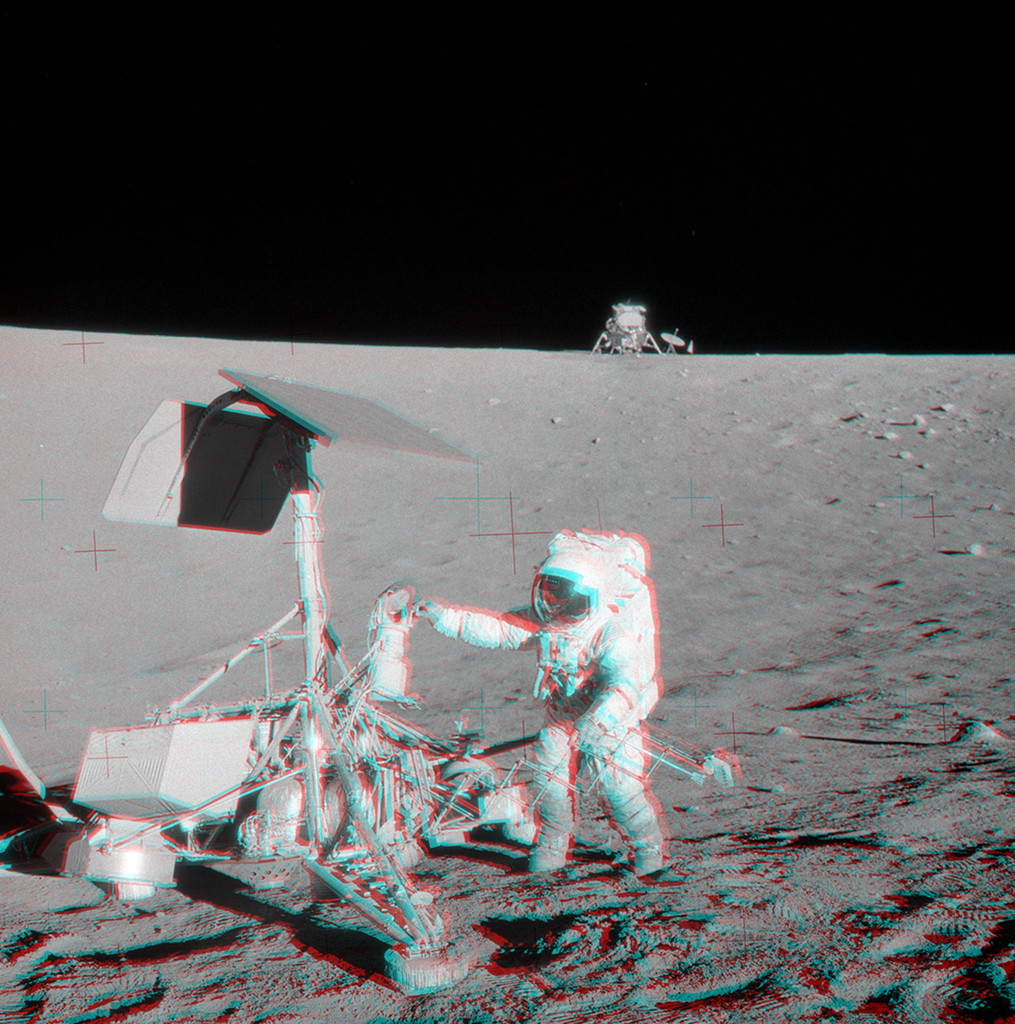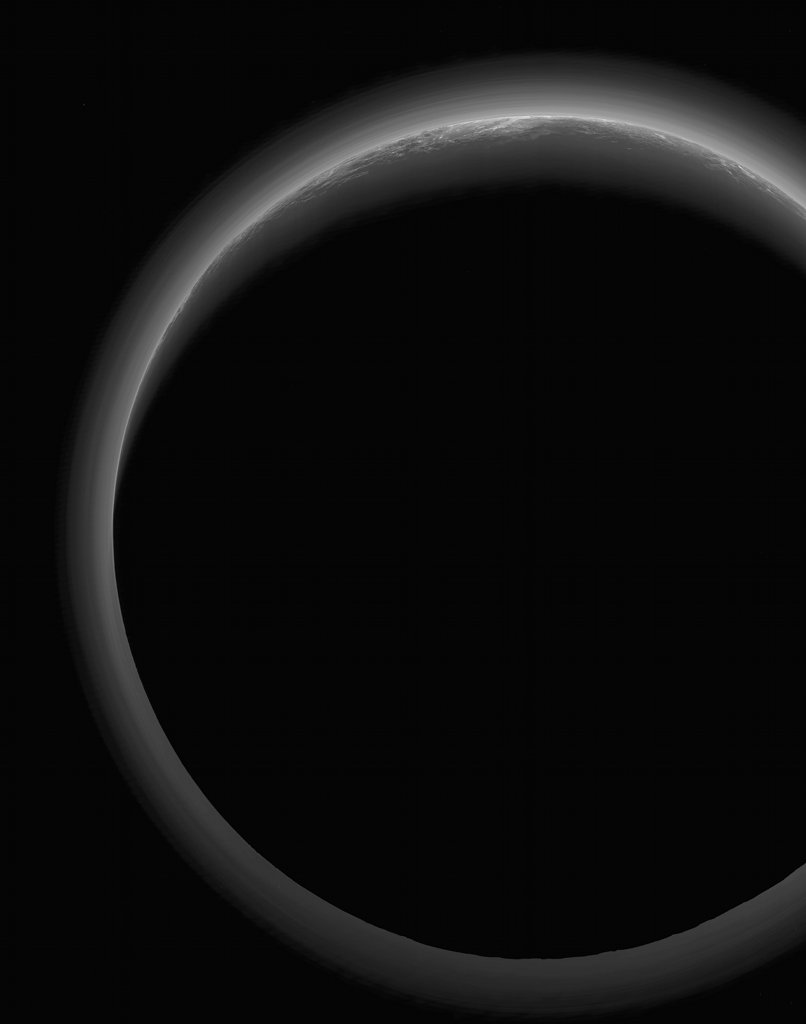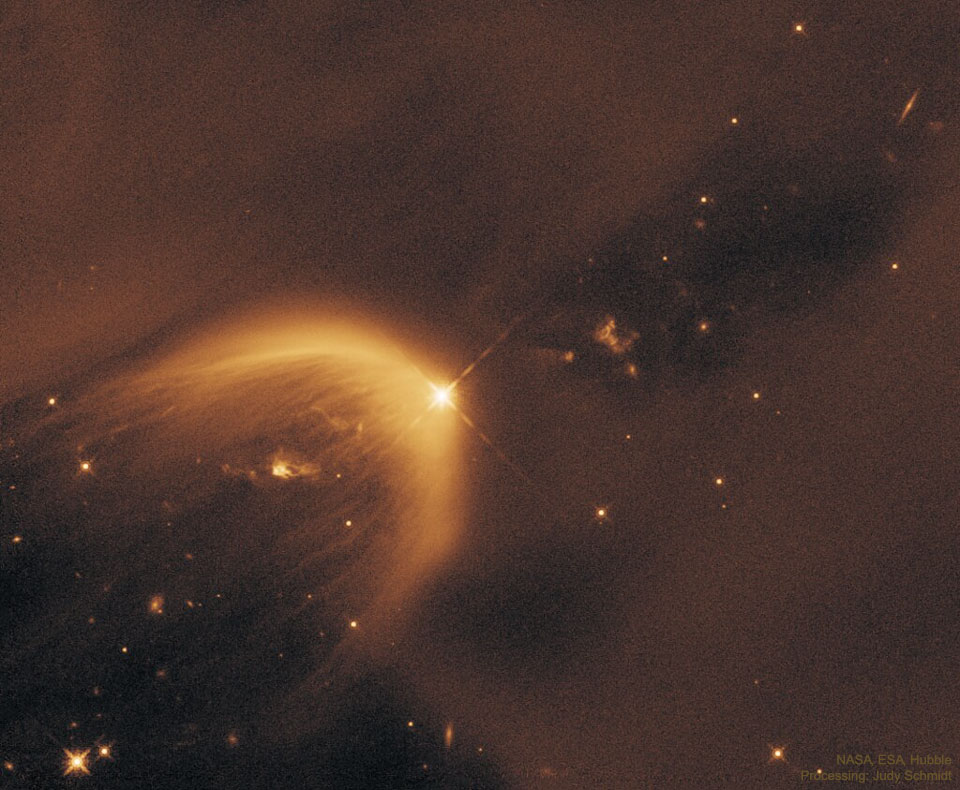| Title: Astronomy Picture of the Day | |
| friendsoffortiesfive > General > General Discussion | Go to subcategory: |
| Author | Content |
|
Niceguy2
|
|
|
Date Posted:03/06/2014 11:29 PMCopy HTML I really love this site and |
|
|
Niceguy2
|
#5726 |
|
Re:Astronomy Picture of the Day Date Posted:11/01/2024 2:41 AMCopy HTML Image Credit & Copyright: Simone Curzi Explanation: By starlight, this eerie visage shines in the dark with a crooked profile evoking its popular name, the Witch Head Nebula. In fact, this entrancing telescopic portrait gives the impression that a witch has fixed her gaze on Orion's bright supergiant star Rigel. More formally known as IC 2118, the Witch Head Nebula spans about 50 light-years and is composed of interstellar dust grains reflecting Rigel's starlight. The color of the Witch Head Nebula is caused not only by Rigel's intense blue light, but because the dust grains scatter blue light more efficiently than red. The same physical process causes Earth's daytime sky to appear blue, although the scatterers in Earth's atmosphere are molecules of nitrogen and oxygen. Rigel and this dusty cosmic crone are about 800 light-years away. You may still see a few witches in your neighborhood tonight though, so have a safe and Happy Halloween! |
|
|
Niceguy2
|
#5727 |
|
Re:Astronomy Picture of the Day Date Posted:11/02/2024 3:14 AMCopy HTML Image Credit & Copyright: John Hayes Explanation: Big, beautiful spiral galaxy NGC 6744 is nearly 175,000 light-years across, larger than our own Milky Way. It lies some 30 million light-years distant in the southern constellation Pavo but appears as only a faint smudge in the eyepiece of a small telescope. We see the disk of the nearby island universe tilted towards our line of sight in this remarkably deep and detailed galaxy portrait, a telescopic image that spans an area about the angular size of a full moon. In it, the giant galaxy's elongated yellowish core is dominated by the light from old, cool stars. Beyond the core, grand spiral arms are filled with young blue star clusters and speckled with pinkish star forming regions. An extended arm sweeps past smaller satellite galaxy NGC 6744A at the upper left. NGC 6744's galactic companion is reminiscent of the Milky Way's satellite galaxy the Large Magellanic Cloud. |
|
|
Niceguy2
|
#5728 |
|
Re:Astronomy Picture of the Day Date Posted:11/03/2024 1:43 AMCopy HTML Image Credit: NASA, JPL-Caltech, Space Science Institute, Mindaugas Macijauskas Explanation: Saturn is bright in Earth's night skies. Telescopic views of the outer gas giant planet and its beautiful rings often make it a star at star parties. But this stunning view of Saturn's rings and night side just isn't possible from telescopes in the vicinity of planet Earth. Peering out from the inner Solar System they can only bring Saturn's day side into view. In fact, this image of Saturn's slender sunlit crescent with night's shadow cast across its broad and complex ring system was captured by the Cassini spacecraft. A robot spacecraft from planet Earth, Cassini called Saturn orbit home for 13 years before it was directed to dive into the atmosphere of the gas giant on September 15, 2017. This magnificent mosaic is composed of frames recorded by Cassini's wide-angle camera only two days before its grand final plunge. Saturn's night will not be seen again until another spaceship from Earth calls. |
|
|
Niceguy2
|
#5729 |
|
Re:Astronomy Picture of the Day Date Posted:11/04/2024 3:19 AMCopy HTML Image Credit: NASA, Juno, SwRI, MSSS; Processing & License: Gerald Eichstädt & Sean Doran Explanation: What's that black spot on Jupiter? No one is sure. During one pass of NASA's Juno over Jupiter, the robotic spacecraft imaged an usually dark cloud feature informally dubbed the Abyss. Surrounding cloud patterns show the Abyss to be at the center of a vortex. Since dark features on Jupiter's atmosphere tend to run deeper than light features, the Abyss may really be the deep hole that it appears -- but without more evidence that remains conjecture. The Abyss is surrounded by a complex of meandering clouds and other swirling storm systems, some of which are topped by light colored, high-altitude clouds. The featured image was captured in 2019 while Juno passed only about 15,000 kilometers above Jupiter's cloud tops. The next close pass of Juno near Jupiter will be in about three weeks. |
|
|
Niceguy2
|
#5730 |
|
Re:Astronomy Picture of the Day Date Posted:11/05/2024 2:19 AMCopy HTML Credit & Copyright: Fényes Lóránd Explanation: The Great Nebula in Orion, an immense, nearby starbirth region, is probably the most famous of all astronomical nebulas. Here, glowing gas surrounds hot young stars at the edge of an immense interstellar molecular cloud only 1500 light-years away. In the featured deep image in assigned colors highlighted by emission in oxygen and hydrogen, wisps and sheets of dust and gas are particularly evident. The Great Nebula in Orion can be found with the unaided eye near the easily identifiable belt of three stars in the popular constellation Orion. In addition to housing a bright open cluster of stars known as the Trapezium, the Orion Nebula contains many stellar nurseries. These nurseries contain much hydrogen gas, hot young stars, proplyds, and stellar jets spewing material at high speeds. Also known as M42, the Orion Nebula spans about 40 light years and is located in the same spiral arm of our Galaxy as the Sun. |
|
|
Niceguy2
|
#5731 |
|
Re:Astronomy Picture of the Day Date Posted:11/06/2024 3:29 AMCopy HTML Credit & Copyright: Josh Dury Explanation: Why were the statues on Easter Island built? No one is sure. What is sure is that over 900 large stone statues called moais exist there. The Rapa Nui (Easter Island) moais stand, on average, over twice as tall as a person and have over 200 times as much mass. It is thought that the unusual statues were created about 600 years ago in the images of local leaders of a vibrant and ancient civilization. Rapa Nui has been declared by UNESCO to a World Heritage Site. Pictured here, some of the stone giants were imaged last month under the central band of our Milky Way galaxy. Previously unknown moais are still being discovered. |
|
|
Niceguy2
|
#5732 |
|
Re:Astronomy Picture of the Day Date Posted:11/06/2024 3:29 AMCopy HTML
|
|
|
Niceguy2
|
#5733 |
|
Re:Astronomy Picture of the Day Date Posted:11/07/2024 2:39 AMCopy HTML Credit & Copyright: Alessandra Masi Explanation: Comet Tsuchinshan-Atlas is now headed back to the outer Solar System. The massive dusty snowball put on quite a show during its trip near the Sun, resulting in many impressive pictures from planet Earth during October. The featured image was taken in mid-October and shows a defining visual feature of the comet -- its impressive anti-tail. The image captures Comet C/2023 A3 (Tsuchinshan–ATLAS) with impressively long dust and ion tails pointing up and away from the Sun, while the strong anti-tail -- composed of more massive dust particles -- trails the comet and points down and (nearly) toward the recently-set Sun. In the foreground is village of Tai di Cadore, Italy, with the tremendous Dolomite Mountains in the background. Another comet, C/2024 S1 (ATLAS), once a candidate to rival Comet Tsuchinshan-Atlas in brightness, broke up last week during its close approach to our Sun. |
|
|
Niceguy2
|
#5734 |
|
Re:Astronomy Picture of the Day Date Posted:11/08/2024 3:18 AMCopy HTML Image Credit & Copyright: George Williams Explanation: This spectacular intergalactic skyscape features Arp 227, a curious system of galaxies from the 1966 Atlas of Peculiar Galaxies. Some 100 million light-years distant within the boundaries of the constellation Pisces, Arp 227 consists of the two galaxies prominent above and left of center, the shell galaxy NGC 474 and its blue, spiral-armed neighbor NGC 470. The readily apparent shells and star streams of NGC 474 are likely tidal features originating from the accretion of another smaller galaxy during close gravitational encounters that began over a billion years ago. The large galaxy on the bottom righthand side of the deep image, NGC 467, appears to be surrounded by faint shells and streams too, evidence of another merging galaxy system. Intriguing background galaxies are scattered around the field that also includes spiky foreground stars. Of course, those stars lie well within our own Milky Way Galaxy. The telescopic field of view spans 25 arc minutes or just under 1/2 degree on the sky. |
|
|
Niceguy2
|
#5735 |
|
Re:Astronomy Picture of the Day Date Posted:11/09/2024 1:58 AMCopy HTML Image Credit & Copyright: Francesco Radici Explanation: Drifting near the plane of our Milky Way galaxy these dusty molecular clouds seem to extend a helping hand on a cosmic scale. Part of a local complex of star-forming interstellar clouds they include LDN 1358, 1357, and 1355 from American astronomer Beverly Lynds' 1962 Catalog of Dark Nebulae. Presenting a challenging target for astro-imagers, the obscuring dark nebulae are nearly 3,000 light-years away, toward rich starfields in the northern constellation Cassiopeia. At that distance, this deep, telescopic field of view would span about 80 light-years. |
|
|
Niceguy2
|
#5736 |
|
Re:Astronomy Picture of the Day Date Posted:11/10/2024 2:37 AMCopy HTML Image Credit & Copyright: Voyager 2, NASA Explanation: Ice giant Neptune is faint in Earth's night sky. Some 30 times farther from the Sun than our fair planet, telescopes are needed to catch a glimpse of the dim and distant world. This dramatic view of Neptune's night just isn't possible for telescopes in the vicinity of planet Earth though. Peering out from the inner Solar System they can only bring Neptune's day side into view. In fact this night side image with Neptune's slender crescent next to the crescent of its large moon Triton was captured by Voyager 2. Launched from planet Earth in 1977 the Voyager 2 spacecraft made a close fly by of the Solar System's outermost planet in 1989, looking back on Neptune at night as the robotic spacecraft continued its voyage to interstellar space. |
|
|
Niceguy2
|
#5737 |
|
Re:Astronomy Picture of the Day Date Posted:11/11/2024 2:51 AMCopy HTML Image Credit: NASA, USGS, Viking Project Explanation: The largest canyon in the Solar System cuts a wide swath across the face of Mars. Named Valles Marineris, the grand valley extends over 3,000 kilometers long, spans as much as 600 kilometers across, and delves as much as 8 kilometers deep. By comparison, the Earth's Grand Canyon in Arizona, USA is 800 kilometers long, 30 kilometers across, and 1.8 kilometers deep. The origin of the Valles Marineris remains unknown, although a leading hypothesis holds that it started as a crack billions of years ago as the planet cooled. Several geologic processes have been identified in the canyon. The featured mosaic was created from over 100 images of Mars taken by Viking Orbiters in the 1970s. |
|
|
Niceguy2
|
#5738 |
|
Re:Astronomy Picture of the Day Date Posted:11/12/2024 2:30 AMCopy HTML Image Credit & Copyright: Bray Falls Explanation: What created an unusual dark streak in Comet Tsuchinshan-Atlas's tail? Some images of the bright comet during mid-October not only caught its impressively long tail and its thin anti-tail, but a rather unexpected feature: a dark streak in the long tail. The reason for the dark streak is currently unclear and a topic of some debate. Possible reasons include a plume of dark dust, different parts of the bright tail being unusually superposed, and a shadow of a dense part of the coma on smaller dust particles. The streak is visible in the featured image taken on October 14 from Texas, USA. To help future analyses, if you have taken a good image of the comet that clearly shows this dark streak, please send it in to APOD. Comet Tsuchinshan–ATLAS has now faded considerably and is returning to the outer Solar System. |
|
|
Niceguy2
|
#5739 |
|
Re:Astronomy Picture of the Day Date Posted:11/13/2024 3:12 AMCopy HTML Image Credit & Copyright: Team ARO Explanation: How was the Crescent Nebula created? Looking like an emerging space cocoon, the Crescent Nebula, visible in the center of the featured image, was created by the brightest star in its center. A leading progenitor hypothesis has the Crescent Nebula beginning to form about 250,000 years ago. At that time, the massive central star had evolved to become a Wolf-Rayet star (WR 136), shedding its outer envelope in a strong stellar wind, ejecting the equivalent of our Sun's mass every 10,000 years. This wind impacted surrounding gas left over from a previous phase, compacting it into a series of complex shells, and lighting it up. The Crescent Nebula, also known as NGC 6888, lies about 4,700 light-years away in the constellation of Cygnus. Star WR 136 will probably undergo a supernova explosion sometime in the next million years. |
|
|
Niceguy2
|
#5740 |
|
Re:Astronomy Picture of the Day Date Posted:11/14/2024 3:06 AMCopy HTML Image Credit: NASA, ESA, CSA, Janice Lee (NOIRLab) - Processing: Alyssa Pagan (STScI) Explanation: A mere 56 million light-years distant toward the southern constellation Fornax, NGC 1365 is an enormous barred spiral galaxy about 200,000 light-years in diameter. That's twice the size of our own barred spiral Milky Way. This sharp image from the James Webb Space Telescope's Mid-Infrared Instrument (MIRI) reveals stunning details of this magnificent spiral in infrared light. Webb's field of view stretches about 60,000 light-years across NGC 1365, exploring the galaxy's core and bright newborn star clusters. The intricate network of dusty filaments and bubbles is created by young stars along spiral arms winding from the galaxy's central bar. Astronomers suspect the gravity field of NGC 1365's bar plays a crucial role in the galaxy's evolution, funneling gas and dust into a star-forming maelstrom and ultimately feeding material into the active galaxy's central, supermassive black hole. |
|
|
Niceguy2
|
#5741 |
|
Re:Astronomy Picture of the Day Date Posted:11/15/2024 4:41 AMCopy HTML Image Credit & Copyright: Ashraf Abu Sara Explanation: A great nebulous region near bright star omicron Persei offers this study in cosmic contrasts. Captured in the telescopic frame the colorful complex of dust, gas, and stars spans about 3 degrees on the sky along the edge of the Perseus molecular cloud some 1000 light-years away. Surrounded by a bluish halo of dust reflected starlight, omicron Persei itself is just left of center. Immediately below it lies the intriguing young star cluster IC 348 recently explored by the James Webb Space Telescope. In silhouette against the diffuse reddish glow of hydrogen gas, dark and obscuring interstellar dust cloud Barnard 3 is at upper right. Of course the cosmic dust also tends to hide newly formed stars and young stellar objects or protostars from prying optical telescopes. At the Perseus molecular cloud's estimated distance, this field of view would span about 50 light-years. |
|
|
Niceguy2
|
#5742 |
|
Re:Astronomy Picture of the Day Date Posted:11/16/2024 3:21 AMCopy HTML Image Credit: NASA, Apollo 12, Alan Bean - Stereo Image Copyright: Kevin Frank Explanation: Put on your red/blue glasses and gaze across the western Ocean of Storms on the surface of the Moon. The 3D anaglyph features Apollo 12 astronaut Pete Conrad visiting the Surveyor 3 spacecraft in November of 1969. Surveyor 3 had landed at the site on the inside slope of a small crater about 2 1/2 years earlier in April of 1967. Visible on the horizon beyond the far crater wall, Apollo 12's Lunar Module Intrepid touched down less than 200 meters (650 feet) away, easy moonwalking distance from the robotic Surveyor spacecraft. This stereo image was carefully created from two separate pictures (AS12-48-7133, AS12-48-7134) captured on the lunar surface. They depict the scene from only slightly different viewpoints, approximating the separation between human eyes. |
|
|
Niceguy2
|
#5743 |
|
Re:Astronomy Picture of the Day Date Posted:11/17/2024 3:28 AMCopy HTML Image Credit: NASA, Johns Hopkins Univ./APL, Southwest Research Institute Explanation: The night side of Pluto spans this shadowy scene. In the stunning spacebased perspective the Sun is 4.9 billion kilometers (almost 4.5 light-hours) behind the dim and distant world. It was captured by far flung New Horizons in July of 2015 when the spacecraft was at a range of some 21,000 kilometers from Pluto, about 19 minutes after its closest approach. A denizen of the Kuiper Belt in dramatic silhouette, the image also reveals Pluto's tenuous, surprisingly complex layers of hazy atmosphere. Near the top of the frame the crescent twilight landscape includes southern areas of nitrogen ice plains now formally known as Sputnik Planitia and rugged mountains of water-ice in the Norgay Montes. |
|
|
Niceguy2
|
#5744 |
|
Re:Astronomy Picture of the Day Date Posted:11/18/2024 3:30 AMCopy HTML Image Credit: Hubble, NASA, ESA; Processing & License: Judy Schmidt Explanation: What is the cause of this unusual parabolic structure? This illuminated cavity, known as LDN 1471, was created by a newly forming star, seen as the bright source at the peak of the parabola. This protostar is experiencing a stellar outflow which is then interacting with the surrounding material in the Perseus Molecular Cloud, causing it to brighten. We see only one side of the cavity -- the other side is hidden by dark dust. The parabolic shape is caused by the widening of the stellar-wind blown cavity over time. Two additional structures can also be seen either side of the protostar; these are known as Herbig-Haro objects, again caused by the interaction of the outflow with the surrounding material. What causes the striations on the cavity walls, though, remains unknown. The featured image was taken by NASA and ESA’s Hubble Space Telescope after an original detection by the Spitzer Space Telescope. |
|
|
Niceguy2
|
#5745 |
|
Re:Astronomy Picture of the Day Date Posted:11/19/2024 4:01 AMCopy HTML Image Credit & Copyright: Malcolm Loro Explanation: Stars can create huge and intricate dust sculptures from the dense and dark molecular clouds from which they are born. The tools the stars use to carve their detailed works are high energy light and fast stellar winds. The heat they generate evaporates the dark molecular dust as well as causing ambient hydrogen gas to disperse and glow. Pictured here, a new open cluster of stars designated IC 1590 is nearing completion around the intricate interstellar dust structures in the emission nebula NGC 281, dubbed the Pac-man Nebula because of its overall shape. The dust cloud just above center is classified as a Bok Globule as it may gravitationally collapse and form a star -- or stars. The Pacman Nebula lies about 10,000 light years away toward the constellation of Cassiopeia. |
|
|
Niceguy2
|
#5746 |
|
Re:Astronomy Picture of the Day Date Posted:11/20/2024 4:11 AMCopy HTML Image Credit & Copyright: Yuri Beletsky (Carnegie Las Campanas Observatory, TWAN); h/t: Alice Allen Explanation: What's happening with these clouds? While it may seem that these long and thin clouds are pointing toward the top of a hill, and that maybe a world-famous observatory is located there, only part of that is true. In terms of clouds, the formation is a chance superposition of impressively periodic undulating air currents in Earth's lower atmosphere. Undulatus, a type of Asperitas cloud, form at the peaks where the air is cool enough to cause the condensation of opaque water droplets. The wide-angle nature of the panorama creates the illusion that the clouds converge over the hill. In terms of land, there really is a world-famous observatory at the top of that peak: the Carnegie Science's Las Campanas Observatory in the Atacama Desert of Chile. The two telescope domes visible are the 6.5-meter Magellan Telescopes. The featured coincidental vista was a surprise but was captured by the phone of a quick-thinking photographer in late September. |
|
|
Niceguy2
|
#5747 |
|
Re:Astronomy Picture of the Day Date Posted:11/21/2024 4:04 AMCopy HTML Image Credit: NASA, Artemis 1 Explanation: Eight billion people are about to disappear in this snapshot from space taken on 2022 November 21. On the sixth day of the Artemis I mission, their home world is setting behind the Moon's bright edge as viewed by an external camera on the outbound Orion spacecraft. Orion was headed for a powered flyby that took it to within 130 kilometers of the lunar surface. Velocity gained in the flyby maneuver was used to reach a distant retrograde orbit around the Moon. That orbit is considered distant because it's another 92,000 kilometers beyond the Moon, and retrograde because the spacecraft orbited in the opposite direction of the Moon's orbit around planet Earth. Orion entered its distant retrograde orbit on November 25. Swinging around the Moon, Orion reached a maximum distance (just over 400,000 kilometers) from Earth on November 28, exceeding a record set by Apollo 13 for most distant spacecraft designed for human space exploration. The Artemis II mission, carrying 4 astronauts around the moon and back again, is scheduled to launch no earlier than September 2025. |








